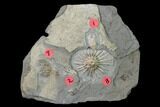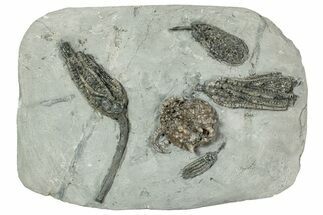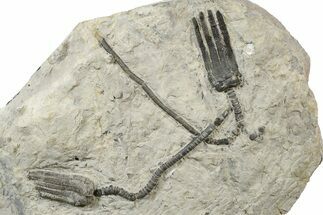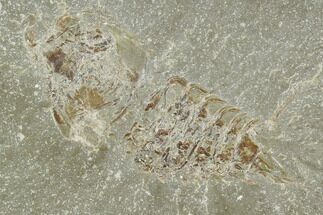This Specimen has been sold.
Four Species of Fossil Crinoids - Gilmore City, Iowa
These are four naturally associated fossil crinoids of the species Aorocrinus iola (#1), Cercidocrinus cirrifer (#2), Dichocrinus multiplex (#7) and Eretmocrinus tentor (#8) from the Gilmore City Formation of Gilmore City, Iowa. The rock has been meticulously removed using air abrasives to reveal the beautifully preserved structures of these crinoids.
#1 - Aorocrinus iola (.5" long)
#2 - Cercidocrinus cirrifer (.4" long)
#7 - Dichocrinus multiplex (.8" long including stem)
#8 - Eretmocrinus tentor (1.1" wide)
#1 - Aorocrinus iola (.5" long)
#2 - Cercidocrinus cirrifer (.4" long)
#7 - Dichocrinus multiplex (.8" long including stem)
#8 - Eretmocrinus tentor (1.1" wide)
Crinoids, sometimes commonly referred to as sea lilies, are animals, not plants. They are echinoderms related to starfish, sea urchins, and brittle stars. Many crinoid traits are like other members of their phylum; such traits include tube feet, radial symmetry, a water vascular system, and appendages in multiples of five (pentameral). They first appeared in the Ordovician (488 million years ago) and some species are still alive today.
SPECIES
Dichocrinus multiplex, Aorocrinus iola, Cercidocrinus cirrifer & Eretmocrinus tentor
LOCATION
Gilmore City, Iowa
FORMATION
Gilmore City Formation
SIZE
2.4 x 1.9" rock
CATEGORY
SUB CATEGORY
ITEM
#157223
We guarantee the authenticity of all of our specimens.
 Reviews
Reviews













